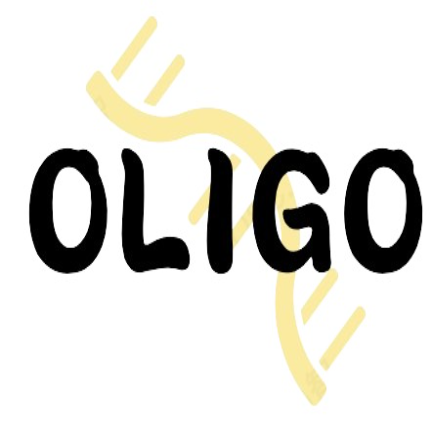OLIGO
Python object for reading oligo files. Oligo is essentially a txt file, contains head and body. Sample file is in path(tests/test_data/test.oligo).
1 |
|
header
All start with #, which records the characteristic information of the oligonucleotide.
| Attributes | Use | Sample |
|---|---|---|
| name | info | oligo1 |
| group | info | G-oligo1 |
| type | Nucleotide species | DNA |
| origin | source of oligonucleotides | hg19;hg19_gtf;1:chr1:1:10000:+ |
| origin_tools | tools | bedtools;v1.0;default |
| target | target region | hg19;hg19_gtf;1:chr1:1:10000:+ |
| origin_tools | tools | bowtie2;v1.0;default |
| negative | negative region | mm10;;1:chr2:1:10000:- |
| negative_tools | tools | blast;v1.0;default |
| hkmer | hkmer jf | mm10;; |
| hkmer_tools | tools | jellyfish;v1.0;default |
| temp | Binding temperature range | 35;45 |
| temp_tools | tools | nupcak;v1.0;default |
| ss | secondary structures range | 0;0.3 |
| ss_tools | tools | nupcak;v1.0;default |
| date | info | 20240423 |
| author | info | ilead-cong |
| info | 2119452560@qq.com | |
| add | info | 5’-AATTCC |
| other_info | info | nice oligo |
name
For an oligo file, oligo name is required.
group
Group is used to classify and organize oligo files and is optional. If it does not exist, the default is to add G- in front of the name attribute, like ‘ G-{oligo.name}’
type
types of oligonucleotides: DNA or RNA.
origin
The source of oligonucleotides, including genome, annotation, and location. The three are separated by semicolons, like {genome;annotation;location} or {genome1,genome2,genome3;annotation1,annotation2,annotation3;location1,location2,location3}. More info: genome1 <-> annotation1 <-> location1.
genome: Record the identity information of the reference genome fa file, such as version name or download address, separated by commas, like
{fa1_URL,fa2_URL,fa3_version}.annotation: Record the identity information of the reference genome gtf file, such as version name or download address, separated by commas, like
{gtf1_URL,gtf2_URL,fa3_version}.location: Record the identity information of the reference genome location information,separated by commas, like
{location1,location2,location3}.more info: The location attribute consists of genomeid, chromosome name, starting position, ending position, and positive and strands, separated by colons, like
{geonemid,chrom,start,end,strand}or{genomeid,all}.If the strand value in the location does not exist, the default is the+strand.
target
The target region targeted by the oligonucleotide. The format refers to the origin attribute.
negative
The negative target region targeted by the oligonucleotide. The format refers to the origin attribute.
hkmer
The high frequency k-mers target region targeted by the oligonucleotide. The format refers to the origin attribute.
origin_tools
Record the tools used by origin, including tool name, version, and parameters, separated by semicolons, like {tools;version;params} or {tools1,tools2;version1,version2;param1,param2}.
More info: if the location attribute of the origin exists, it corresponds to one; otherwise, it corresponds to the genome attribute.
target_tools
Record the tools used by target, the format refers to the origin_tools attribute.
negative_tools
Record the tools used by negative, the format refers to the origin_tools attribute.
hkmer_tools
Record the tools used by hkmer, the format refers to the hkmer_tools attribute.
temp
Binding temperature of oligonucleotide and its reverse complement, like {low,high}.
temp_tools
Record the tools used by temp, like {tools,version,param}.
ss
Probability of oligonucleotides forming secondary structures, like {low,high}.
ss_tools
Record the tools used by ss, like {tools,version,param}.
date
Date the oligonucleotide was produced.
author
Creator of oligonucleotide generation.
The creator’s email address of the oligonucleotide generated.
add
Add fixed sequence at the 3’ or 5’ end of the oligo sequence.
other_info
Other information that needs to be recorded.
body
Tab-delimited matrix file with column names, used to record oligonucleotide details.
